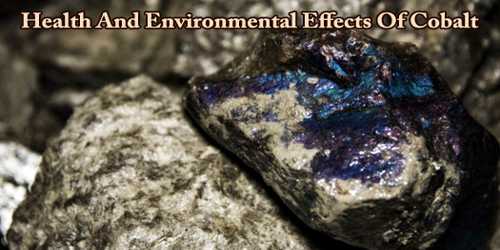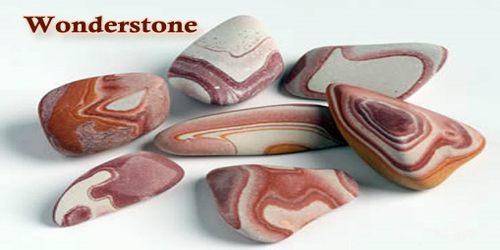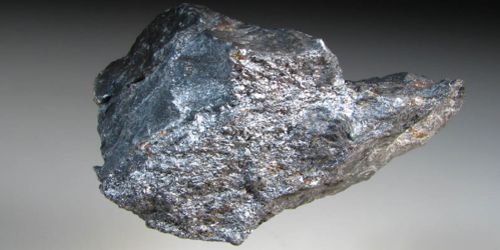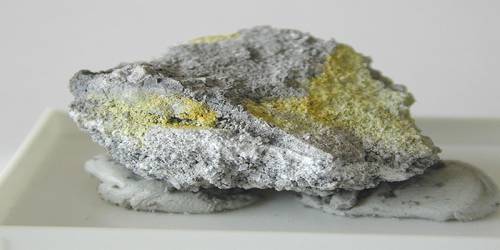Cobalt is a hard gray metal element. It’s part of vitamin B-12. This vitamin is essential for making red blood cells. It also maintains the nervous system. It is a member of group VIII of the periodic table. Like iron, it can be magnetized. It is similar to iron and nickel in its physical properties. The element is active chemically, forming many compounds. Cobalt is stable in air and unaffected by water, but is slowly attacked by dilute acids.
Cobalt is essential to the metabolism of all animals. It is a key constituent of cobalamin, also known as vitamin B12, the primary biological reservoir of cobalt as an ultratrace element. Bacteria in the stomachs of ruminant animals convert cobalt salts into vitamin B12, a compound which can only be produced by bacteria or archaea. A minimal presence of cobalt in soils therefore markedly improves the health of grazing animals, and an uptake of 0.20 mg/kg a day is recommended because they have no other source of vitamin B12.
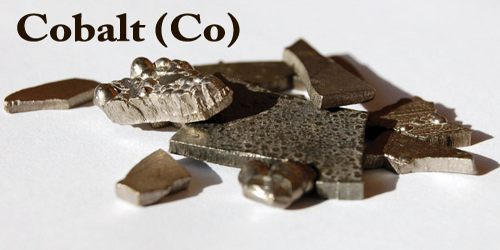
Health Effects –
As cobalt is widely dispersed in the environment humans may be exposed to it by breathing air, drinking water and eating food that contains cobalt. Skin contact with soil or water that contains cobalt may also enhance exposure. Cobalt is not often freely available in the environment, but when cobalt particles are not bound to soil or sediment particles the uptake by plants and animals is higher and accumulation in plants and animals may occur.
Cobalt is beneficial for humans because it is a part of vitamin B12, which is essential for human health. Cobalt is used to treat anaemia with pregnant women, because it stimulates the production of red blood cells. The total daily intake of cobalt is variable and may be as much as 1 mg, but almost all will pass through the body unadsorbed, except that in vitamine B12.
However, too high concentrations of cobalt may damage human health. When we breathe in too high concentrations of cobalt through air we experience lung effects, such as asthma and pneumonia. This mainly occurs with people that work with cobalt.
When plants grow on contaminated soils they will accumulate very small particles of cobalt, especially in the parts of the plant we eat, such as fruits and seeds. Soils near mining and melting facilities may contain very high amounts of cobalt, so that the uptake by humans through eating plants can cause health effects.
There are no known food or medicine interactions with cobalt. There have been reports of high levels of cobalt in people who had hip replacements that used a metal-on-metal devices. Symptoms of a higher level of cobalt in blood are:
- Fatigue
- Weakness
- Peripheral neuropathy
- Hearing loss
- Visual loss
- Cognitive decline
- Cardiomyopathy
- Hypothyroidism
Health effects may also be caused by radiation of radioactive cobalt isotopes. This can cause sterility, hair loss, vomiting, bleeding, diarrhoea, coma, and even death. This radiation is sometimes used with cancer-patients to destroy tumors. These patients also suffer from hair loss, diarrhea, and vomiting.
Cobalt dust may cause an asthma-like disease with symptoms ranging from cough, shortness of breath and dyspnea to decreased pulmonary function, nodular fibrosis, permanent disability, and death. Exposure to cobalt may cause weight loss, dermatitis, and respiratory hypersensitivity. LD 50 (oral, rat)- 6171 mg/kg. (LD50 = Lethal dose 50 = Single dose of a substance that causes the death of 50% of an animal population from exposure to the substance by any route other than inhalation. LD50 is usually expressed as milligrams or grams of material per kilogram of animal weight (mg/kg or g/kg).)
Furthermore, cobalt metal is suspected of causing cancer (i.e., possibly carcinogenic, IARC Group 2B) as per the International Agency for Research on Cancer (IARC) Monographs. It causes respiratory problems when inhaled. It also causes skin problems when touched; after nickel and chromium, cobalt is a major cause of contact dermatitis. These risks are faced by cobalt miners. Cobalt can be effectively absorbed by charred pigs’ bones; however, this process is inhibited by copper and zinc, which have greater affinities to bone char.
Cobalt is a major part of vitamin B12. So if any people get enough vitamin B12, they will also get enough cobalt. Adults need approximately 1.5 micrograms of vitamin B12 a day. Having high amounts of cobalt for long periods of time could affect the heart and might decrease fertility in men. Having too much cobalt could be harmful. But cobalt isn’t currently used in supplements in the UK, and the amount we get from food isn’t harmful. Having 1.4mg or less a day of cobalt supplements is unlikely to cause any harm.
Environmental Effects –
The word ‘cobalt’ is derived from the German ‘kobalt’, from kobold meaning “goblin”, a superstitious term used for the ore of cobalt by miners. The first attempts to smelt those ores for copper or nickel failed, yielding simply powder (cobalt(II) oxide) instead. Because the primary ores of cobalt always contain arsenic, smelting the ore oxidized the arsenic into the highly toxic and volatile arsenic oxide, adding to the notoriety of the ore.
Cobalt is an element that occurs naturally in the environment in air, water, soil, rocks, plants and animals. It may also enter air and water and settle on land through wind-blown dust and enter surface water through run-off when rainwater runs through soil and rock containing cobalt.
Humans add cobalt by releasing small amounts into the atmosphere from coal combustion and mining, processing of cobalt-containing ores and the production and use of cobalt chemicals. The radioactive isotopes of cobalt are not present in the environment naturally, but they are released through nuclear power plant operations and nuclear accidents. Because they have relatively short half-lives they are not particularly dangerous.
Cobalt cannot be destroyed once it has entered the environment. It may react with other particles or adsorb on soil particles or water sediments. Cobalt will only mobilize under acidic conditions, but ultimately most cobalt will end up in soils and sediments. Soils that contain very low amounts of cobalt may grow plants that have a deficiency of cobalt. When animals graze on these grounds they suffer from lack of cobalt, which is essential for them.
On the other hand, soils near mining and melting facilities may contain very high amounts of cobalt, so that the uptake by animals through eating plants can cause health effects. Cobalt will accumulate in plants and in the bodies of animals that eat these plants, but cobalt is not known to bio magnify up the food chain. Because of this fruits, vegetables, fish and other animals we eat will usually not contain very high amounts of cobalt.
It has been argued that cobalt will be one of the main objects of geopolitical competition in a world running on renewable energy and dependent on batteries, but this perspective has also been criticized for underestimating the power of economic incentives for expanded production.
Information Sources:
